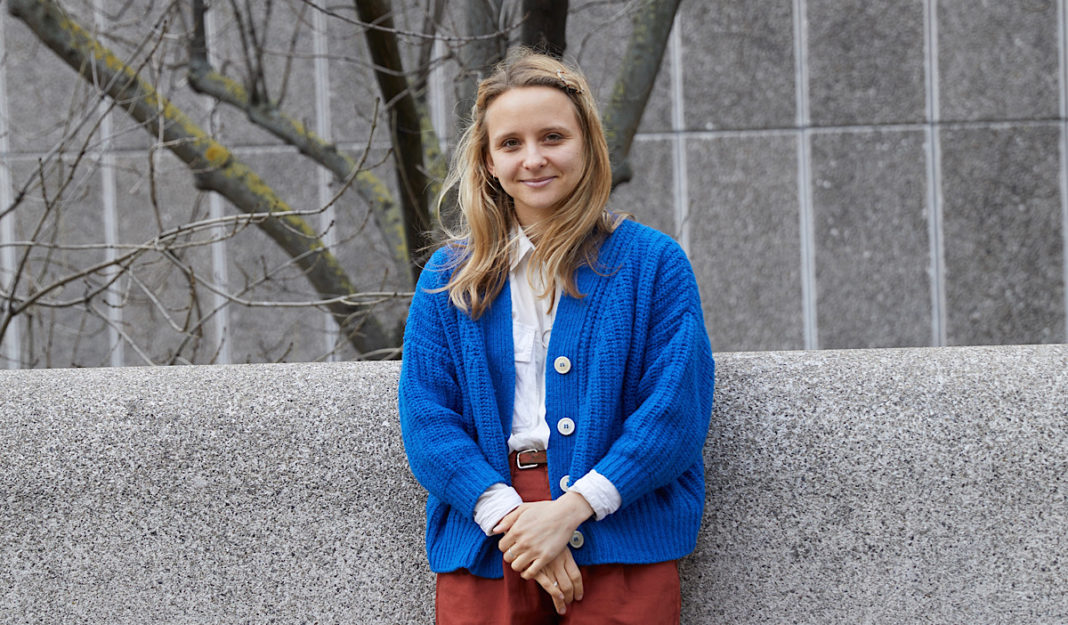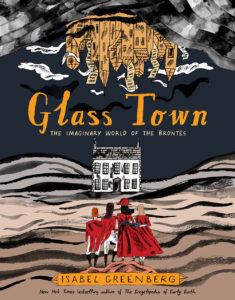Isabel Greenberg displayed her remarkable mythological world-building prowess with The Encyclopedia of Early Earth and The One-Hundred Nights of Hero. With Glass Town: The Imaginary World of the Brontës, one of the 65 anticipated graphic novels the Beat spotlighted for March, Greenberg has surpassed her previous efforts as she brings fresh context to and expands upon the remarkable secret world of the Brontë siblings.
After the death of elder siblings Maria and Elizabeth, the remaining Brontë children (Charlotte, Branwell, Emily and Anne) embark on creating a fictional world to serve as an escape from their dreary lives. Glass Town, their imaginary world, weaves between past and present, fiction and reality and mirrors the Brontës’ experiences with sibling rivalries, romance and artistic expression.
Greenberg talked to The Beat about Glass Town and her approach on expanding upon the Brontës’ mesmerizing fictional universe.
Nancy Powell: Were you a big fan of the Brontës before Glass Town?
Isabel Greenberg: I was absolutely a fan of their novels growing up. I’d read them and of course seen various TV and film adaptations, but I knew nothing at all about their juvenilia. For me the story behind both the juvenilia and their subsequent novels, makes them more extraordinary.
Powell: Which sister and/or book was your favorite?
Greenberg: When I was younger, Jane Eyre was my favourite. I enjoyed Wuthering Heights very much, but I don’t think I fully appreciated it until I reread it as an adult. I also had not read any of Anne’s works until I was an adult. Knowing what I know about their lives, all of their works are extraordinarily radical, albeit in different ways. Jane Eyre is my favourite for dialogue. Wuthering Heights I think is actually so funny in places, and also just wild and strange. And the Tenant of Wildfell Hall is an incredible book for a woman of that time to have written. It deals with an alcoholic husband and a woman who leaves him with her child and seeks to make her own way in the world.That doesn’t totally answer your question…I guess if I really had to pick, Jane Eyre. But I think I would get on well with Anne the best!
Powell: I find your artistic style melds with the Gothic sensibility of the Brontës. How did you approach this project and did you have this style in mind for Glass Town before you began?
Greenberg: The style kind of came naturally as I was working. I knew I wanted to approach it in a slightly different visual language to my previous two graphic novels, and I was exploring some new materials, so it happened quite naturally. I worked in pencil and charcoal, which gave it a dark and textured feel without me having to do much! The colours I considered very carefully, as they help to differentiate between the three different plot strands, each of which happen in a different time and place, and we jump between them. The colour changes were intended to both clarify where you are in the story, but also signal the mood and tone. So the present day is blues and greys; sombre. The past in the real world is sepia tinted, pinks and reds. And then the imaginary world is in full colour, a stark contrast to the muted reality.
Powell: How much research did you do to capture the essence of their juvenilia?
Greenberg: I did a lot of research. I read my way through a lot of the juvenilia, but also tried to find lots of commentary and information by biographers and writers on it. For me one of the most important things was how their reality and fiction blended, so it was key to me to try and understand where they were in their lives when they wrote it. In a way, the hardest part was having to put aside so much of the great material I discovered, I just couldn’t include it all! There’s a great story Charlotte wrote called ‘The Spell’ in which it’s revealed that Zamorna has a twin brother, but a mysterious curse means that if they are ever seen together they would both die. I couldn’t shoe horn that one in!
Powell: Had you visited Haworth Parsonage before this project?
Greenberg: I hadn’t. I went up about four times over the course of the project. My first visit was very early on, and I simply walked around, soaked up the atmosphere, and went on the moors. But I went back twice subsequently to sketch and draw around the parsonage. I drew room plans so I could get a feel for how the house connected. The atmosphere of the place is very special. On my second visit I was significantly deep into the research stage that all I was thinking about was the Brontës, and I was really very moved by it. There is something incredible about the way it has kept the past alive, and the sheer number of people you see walking around the town, who have come just for them, only adds to the magic of it.
Powell: You make the alter egos of the Brontës feel alive, and like extensions of their real selves. Being that this is a fictional re-imagining of their childhood stories, how much was based on fact? Did you feel any qualms about extending the arc of Glass Town beyond what the Brontës imagined?
Greenberg: I didn’t. I felt that since the juvenilia had never been intended to be published, and that they themselves treated it as such a fluid work in progress, it was fair to adapt it! I hope they would approve. I also knew that while their novels are universally known and loved, the juvenilia is less explored by the general public, so there was less anxiety on my part about people being upset by changes I had made. I tried to be as accurate as I could be with their biographical details, but after a certain point I decided that I was creating a work of fiction.
Powell: There is a psychological turmoil you depict wonderfully involving blurred realities and the lengths an artist will go in pursuit of their craft, particularly with Charlotte and her imaginary life. Do you find yourself becoming immersed in such a way with the characters and stories you write and draw?
Greenberg: The best part of any project, for me, is the early stages, when I am wrapped up in the story and the writing and constructing the narrative. That’s definitely the place where I become most immersed and could most identify with Charlotte’s descriptions of the blurring of her fiction and reality! But once I had written and penciled it, I then had to draw and colour the entire thing. I love to draw, and so that has a real physical pleasure of my hands just working and making, but it doesn’t engross my head like the writing does. At this point the project becomes something different, and I lose my immersion in the world and think more about pencils and colours and layouts and images. It’s engrossing but in a very different way. More robotic!
Powell: Which set of Brontë characters, person and alter ego, was your favorite to draw?
Greenberg: I think Charles and Charlotte. Charles was the character under whom Charlotte wrote as the most. I found this so interesting, that as a teenage girl she would have chosen the voice of an acerbic man to be a funnel for her own. And he was so funny and dry! When she wrote as him her commentary on the other Glass Towners is very witty and snarky. I loved this, and so I imagined this relationship between them, as creator and creation, in which they spar and debate. I always enjoyed the sections of Jane Eyre where Jane and Rochester have these great, sparky conversations, and so it seemed natural to me that Charlotte and Charles would have that. So those sections were great fun to create. But in terms of who I loved to draw… Zamorna! I had a lot of fun with him, he was such a terrible villain; so vain, so wicked!
Powell: Sibling rivalry plays a role in the narrative arc of their juvenilia. How much of this is a reflection of your own experience with your sister?
Greenberg: Me and my sister are five and a half years apart, so actually as children whilst we argued terribly, we didn’t really compete or work together growing up. The difference between ten and fifteen, five and ten, seemed far too great to contemplate when we were younger! But as we grew up we got closer and closer, and I think the part of the Brontë sibling arc that fascinated me was the tragedy of being the last one left. How utterly lonely for Charlotte, having had these great friends, these collaborators, to have been left as the last one.
Powell: Of all the books you have completed so far, which has been your favorite? Which has been the most difficult?
Greenberg: This one! In terms of being both my favourite but also the hardest to make! I loved working with a subject matter that needed so much immersion in research, and the sculpting and constructing of the narrative ended up being much more complex than in my previous two books.
Powell: Will we see another installment of Early Earth?
Greenberg: Perhaps. I wouldn’t say never, but it’s not currently on the cards!
Published by the Comicarts imprint of Abrams, Glass Town: The Imaginary World of the Brontës is due out in stores on Wednesday, March 11th.









